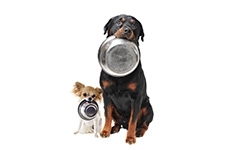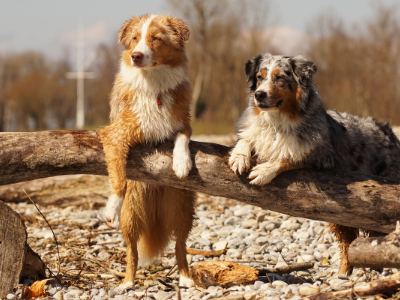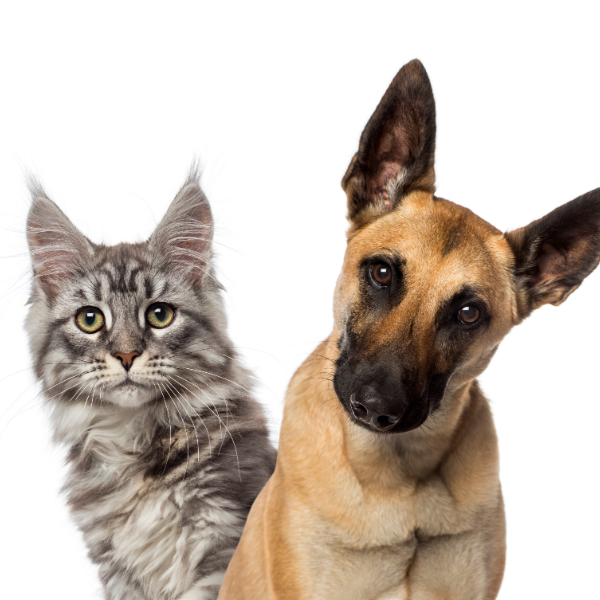For some, feeding a raw diet seems too foreign or inconvenient compared to the easy packaged dry foods that take little to no time to prepare. Pet food companies have taken advantage of the growing demand for “natural”, convenient pet diets and have created low–carb/high-protein dry foods. Many people feel this is a suitable compromise to feeding raw but these products are not comparable. There are many differences in how cats and dogs function on a physiological level depending on which food type is fed. There are three types of dietary energy sources for mammalian species: proteins, carbohydrates, and fats. Over years of clinical studies, it has become apparent that dogs and cats have their own unique requirements for these three sources and that they are not interchangeable. Dogs and cats utilize these energy sources via specific metabolic processes. These functions are a product of millions of years of evolutionary adaptation. Providing these components in unnatural proportions is neither a healthy nor holistic way of feeding your pet. Other largely differentiating factors between dry and raw are the vast differences in moisture percentage and live enzyme content. Long-term systemic dehydration and enzymatic deficiencies can lead to serious disease.
The Physiology of Protein Synthesis
To understand the differences between dry foods and raw foods, we must understand the physiological aspects of how dogs and cats synthesize dietary protein. Proteins are chains of amino acids that when ingested in food are broken down during several digestive processes. The amino acids begin to be broken down into smaller chains in the stomach by the action of hydrochloric acid. Once broken down, small chains or single amino acids are absorbed into the bloodstream via the small intestine. Once in the bloodstream, cells can utilize the nutrients needed. The liver converts excess amino acids into other useable molecules, a process known as deamination. During deamination, the liver converts nitrogen from the amino acids into ammonia which is then converted into urea. Urea is excreted via the kidneys. High blood urea nitrogen (BUN) levels are common in animals that are fed a high protein diet on a regular basis. In recent years, there has been much controversy on what levels of protein are acceptable to maintain health in cats and dogs. This will be addressed further below.
The Physiology of Carbohydrate Synthesis
Carbohydrates are classified into two major groups: soluble & insoluble. Soluble carbohydrates, such as monosaccharides (glucose, sucrose, lactose, dextrin, and starch) are readily available from cooked and processed grains and the digestibility is between 73-85%. This type of nutrient is meant to provide quick bursts of energy to the bloodstream in the form of sugar, which also increases blood glucose levels rapidly. This type of rapid increase can also cause the opposite reaction of blood glucose “crashes” or low blood glucose (hypoglycemia).
Insoluble carbohydrate is otherwise known as fiber and is used as a roughage within the digestive tract. It has been shown to alter lipid (fat) and glucose metabolism. It has also been shown that fiber uptakes glucose and lowers the absorption rate of sugar into the bloodstream. Interestingly, it also increases insulin receptivity in humans. Uncooked/unprocessed grains are indigestible to dogs and cats and they are generally excreted whole.
The Physiology of Fat Synthesis
Fats are referred to as lipids or oils. There are three major functions of dietary fats:
1. To aid in the absorption of fat-soluble vitamins A, D, E, and K
2. As a source of EFA’s (essential fatty acids)
3. To be stored by the body as energy in fat cells
Fats are highly digestible and an excellent source of energy. They yield approximately 2.25 times more energy (in the form of ATP or adenosine triphosphate) than proteins or carbohydrates. Fats are absorbed from the digestive system and are stored in fat cells for long-term energy storage, readily available when needed. The vitamins A, D, E, and K are usually absorbed in fat globules that travel through the lymphatic system of the small intestine. They then enter the general blood circulation and then these fats and vitamins are stored in body tissues or used by the body as needed.
Hydration and Diet
Dogs' and cats' bodies are made up of approximately 60% water. To maintain true health, the body must maintain this water content. Dehydration has severe effects on the health of your pet. There are several ways the body can become systemically dehydrated including extremely high or low-temperature exposure, vomiting, diarrhea, physical exertion, and eating a dry food diet. Animals obtain water by drinking and eating foods that contain water. Dogs will regulate their water intake and naturally have thirst when they become dehydrated. Cats naturally do not have a high thirst drive and tend not to drink enough even when they become dehydrated. Some pet food companies even add salt to induce thirst in cats. This also has an extremely dehydrating effect. Dietary moisture is important for maintaining hydration throughout the digestive process. Dry foods contain very low moisture content and cause the body to pull water from the body via the digestive organs to aid in the digestion of the dry matter within the stomach. Excessive thirst is a sign of dehydration, especially in cats that are highly susceptible to urinary dysfunction and kidney disease.
Dietary Protein and Kidney Health
For decades, it has been widely accepted by animal health care professionals that animals with kidney disease should be maintained with a low-protein diet. Kidney disease is a leading killer of domestic cats and has become a growing problem for dogs. The kidneys are the key filtration system for excreting the waste products of protein. When they do not function correctly, blood urea levels can reach proportions that are unsafe for the animal involved, causing the kidneys to become overworked. This can lead to kidney damage and dysfunction. In past and present years, veterinarians have maintained cats and dogs on low protein dry and canned diets when the kidney disease is diagnosed or there is a concern that it is in the early stages. The idea of feeding a low protein diet is to reduce the workload of the kidneys and reducing BUN and creatinine levels. Unfortunately, there are several major disadvantages to this method. Cats and dogs that are switched to a low protein dry diet often become emaciated and seem to waste away and the animal becomes less resilient. In the past, this wasting was simply explained as a symptom of advancing kidney disease. In recent years, the question has arisen: is the wasting a product of the disease or the diet? Some veterinarians who prefer a natural approach have entertained the possibility of different forms of treatment and dietary management for animals with kidney disease. By way of their ability to think holistically, new understandings have come to light.
The most fascinating and enlightening fact has been that dogs and cats fed a balanced raw diet seem to naturally maintain higher BUN, creatinine and have higher packed red blood cell volume (hematocrit) levels with no signs of kidney distress (increased thirst, anorexia, inability to concentrate urine, lethargy, etc.). High BUN and creatinine levels were traditionally associated with kidney disease and dysfunction. It was originally suggested that healthy BUN levels for dogs were between 25 to 30 mg/dl and creatinine between 0.5-1.6 ml/dl. (Mg/dl means milligrams of material per 100 milliliters of blood.). BUN for cats is 14 to 36 mg/dl and creatinine 0.6-2.4 ml/dl. In 2003, Dr. Jean Dodds, DVM, and Dr. Susan Wynn investigated the basic clinical parameters of 256 healthy dogs being fed a raw diet over at least 9 months when they discovered these key differences in raw fed dogs versus dogs fed a cereal-based diet. Dr. Dodds has suggested that these levels be revised for animals eating raw diets. In my personal experience working as a holistic veterinary assistant and homeopath in a clinical veterinary environment, I have come to the same discovery when reviewing blood results from hundreds of pets eating a variety of diets (mostly raw) and see how their blood work changes as pets are switched from dry to raw foods.
Why is this information significant to our discussion? We must examine the possible reasons why pets on raw can appear healthy when their blood work seems to tell a story of kidney distress. We must look at other key differences in the two ways of feeding to shed more light on the subject.
Dietary Moisture and Kidney Health
Water is considered one of the most important nutrients for mammals. Animals can lose up to half of their glycogen and fat storage and survive where only a 10% loss of body water causes serious illness and loss of 15% results in death. Moisture in dog and cat food is essential for correct digestion and hydration. Ingestion of dry foods causes a dehydrating effect when the body must bring moisture to the stomach to digest the dry food. Naturally, raw-fed dogs and cats drink a fraction of the water that dry-fed pets do. Raw diets contain approximately 60-80% moisture versus dry foods that contain 6-10%. Every time a pet eats a meal of dry food, it becomes dehydrated and thirst follows. Animals eating dry food diets face a daily battle to stay hydrated. Years of systemic dehydration have dire consequences including kidney distress that can lead to chronic renal failure and dysfunction of all other major organs. The kidneys function and filter best when cells in the body are properly hydrated. Feeding high-protein dry diets (up to 50% protein on a dry matter basis) is of concern to me because the kidneys are processing excessive amounts of protein while the body is becoming dehydrated.
When the moisture content is increased in a pet’s food, its thirst naturally diminishes and it is able to function without feeling thirsty throughout the day. A thirsty animal is a dehydrated animal. If you notice your pet drinking water several times per day in large amounts, it is caused to be concerned, whether it is a normal occurrence or a sudden increase in thirst. Your pet should only increase its water intake on very cold or very hot days to compensate for extreme temperature changes or if its body is dealing with some sort of illness or emotional distress. Other causes of increased thirst are ingestion of a foreign object or bad food, diarrhea, and vomiting, all of which should be addressed immediately by a veterinarian.
Dietary Carbohydrates, Proteins, Fats and Blood Glucose Regulation
Commercially produced dry foods contain between 30-70% non-fiber carbohydrates and raw diets little to none. Carnivores technically have no nutritional requirement for carbohydrates and, in the wild; canines would not consume more than 10%, and felines, less than 5%. In the past, cereal-based diets were fed to pets for economical reasons because grains are much less expensive than meat. Unfortunately, carbohydrates do not provide the same nutrients as meats and cannot be considered of equal nutritional value. After years of a clinical study on cereal-based pet foods, it is becoming clear that a grain-based diet is not necessarily the most beneficial for our four-legged friends. Carbohydrate sources used in commercial diets include wheat, rice, barley, oats, and corn. Cooked and extruded forms of these grains are rapidly digested as starches that are converted to sugar and used as energy. Whole forms of these ingredients are difficult for carnivores to digest and are mainly utilized as fiber. Starches and proteins do not provide comparable sources of energy. Starches create sugars (glucose) that increase blood glucose levels. They are quickly converted to sugar and quickly utilized by cells. The unfortunate downfall of this type of energy is that regular sudden increases and decreases in blood glucose are known to be the leading causes of diabetes and hypoglycemia. The more processed the carbohydrate becomes, the more quickly it is utilized which causes “spikes” in blood glucose.
Proteins provide energy from amino acids and are slower to be processed than carbohydrates but are longer-lasting sources of energy. Proteins aid in creating a regulatory effect on blood glucose levels rather than causing “spikes.” Raw diets naturally contain high levels of protein as well as the correct dietary enzymes to synthesize amino acids into usable forms for cells.
Animal fats are essential for carnivorous animals. They are stored as energy to be used in times of need. Fats also store vitamins A, D, E, and K and make them available as the body needs them, aiding in blood glucose regulation when proteins and carbohydrates are not available. Essential fatty acids are known to reduce inflammation of the digestive system, urinary system, joints, and skin. Unprocessed/uncooked animal fats naturally occur in a raw diet but do not in processed foods unless added after cooking occurs. Even when these fats are added to dry food diets, their nutritional value is soon lost when stored on shelves in a bag for months at a time. Fats need to be refrigerated to maintain their nutritional value or they become denatured or even rancid.
Live Dietary Enzymes
The only way for animals to obtain live enzymes from food is to ingest fresh raw foods. Live enzymes do not survive heating of any kind and are denatured when cooked. Each raw food has its own unique set of enzymes that aid in the digestion and absorption of nutrients from raw foods. When they are not present, the body is called upon to produce all of the enzymes needed for digestion. The body is only capable of creating a limited supply of enzymes over its lifetime so dietary enzymes are essential. New studies on human nutrition are shedding light on the importance of live enzymes from raw foods.
The Diet Differences:
Traditional Commercial Dry Diet Nutritional Analyses Ranges for Cats
Crude Protein: 33-36%
Crude Fiber: 6-7%
Crude Fat: 14-17%
Moisture: 6-10%
Traditional Commercial Dry Diet Nutritional Analyses Ranges for Dogs
Crude Protein: 24-28%
Crude Fiber: 2-6%
Crude Fat: 12-14%
Moisture: 6-10%
High Protein/Holistic Dry Diet Nutritional Analyses Ranges for Cats
Crude Protein: 32-50%
Crude Fiber: 1.5-3%
Crude Fat: 18-22%
Moisture: 6-10%
High Protein/Holistic Dry Diet Nutritional Analyses Ranges for Dogs
Crude Protein: 22-44%
Crude Fiber: 2-3%
Crude Fat: 18-22%
Moisture: 6-10%
The Raw Diet Nutritional Analyses Ranges for Dogs and Cats
Crude Protein: 15.5-18.5%
Crude Fiber: 0%
Crude Fat: 3-12.5%
Moisture: 74.5-83%
Conclusion
The four main differences between raw and dry diets: 1. Carbohydrate percentage 2. Moisture percentage 3. Live enzyme content 4. Protein percentage. Upon closer evaluation of these four nutrients, we find that none of them are interchangeable and all must be present in the diet as they would naturally occur. In addition, commercially prepared foods have approximately 68-73% less moisture than a raw food diet. Significant deviations from a naturally balanced ratio of these nutrients may be responsible for countless chronic and acute diseases including but not limited to kidney/liver disease, pancreatitis, and diabetes. High protein dry pet foods contain dehydrated meat sources and while this increases protein significantly, it is not balanced with adequate moisture or live enzymes. When tested, raw diets appear to contain the lowest protein percentage of all the studied diets. This protein is in the most natural and available form for carnivores and includes adequate moisture and live enzymes. More protein is not necessarily better. It is the combination of nutrients fed that is the key to maintaining a healthy pet.



